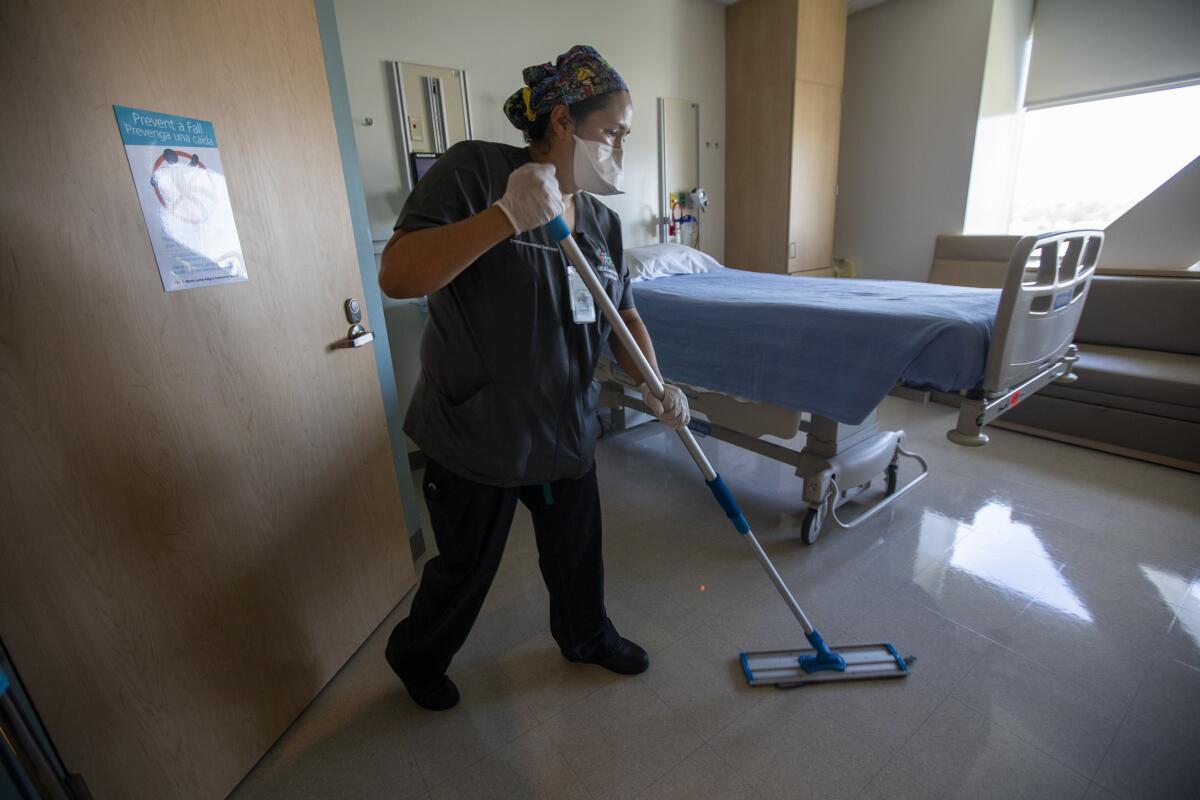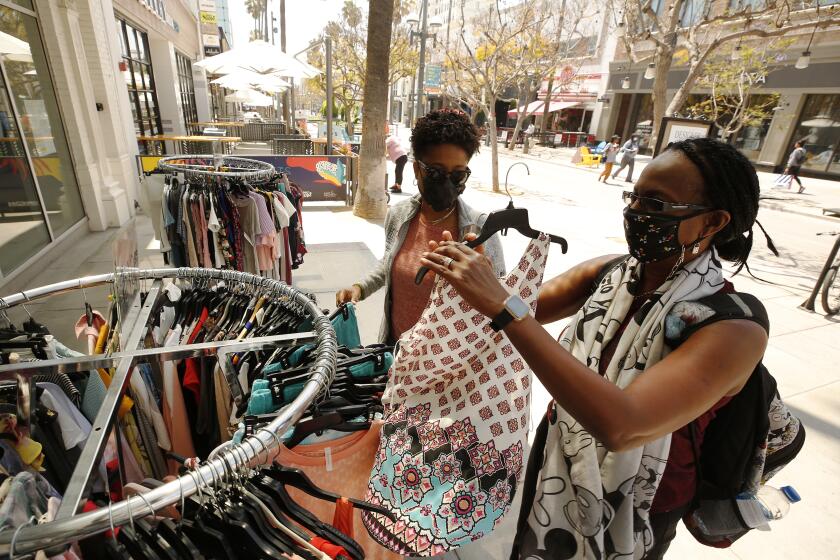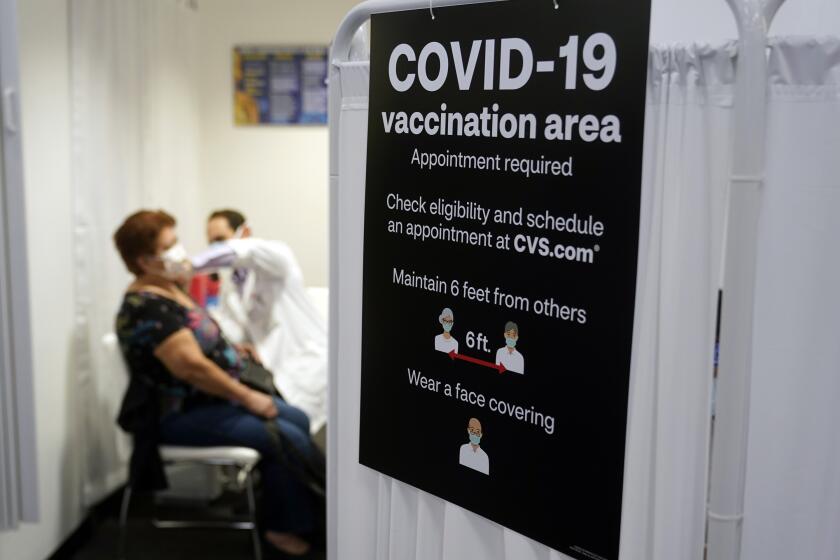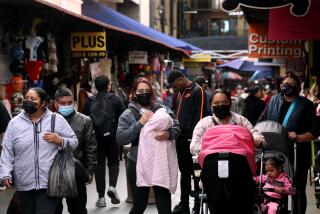In dramatic shift, California COVID-19 hospitalizations are lowest since pandemic’s start

- Share via
In another dramatic sign of how rapidly California is recovering from COVID-19, the state recorded its lowest hospitalization rate since the first few weeks of the pandemic, according to data reviewed by The Times.
The numbers come just months after the winter surge left hospitals across Southern California overwhelmed with patients and caused a spike in deaths.
But over the last three months, COVID-19 has receded rapidly across the region, allowing a massive reopening of the economy and the hope for a return to some kind of normal by the summer.
California is now at the bottom of the nation when it comes to coronavirus case rates. Los Angeles County and San Francisco this week progressed into the least-restrictive tier of California’s color-coded closure system, clearing the way for both areas on Thursday to reopen their economy to the widest extent currently possible.
With more vaccines available and cases plummeting, hospitals are seeing dramatic relief.
L.A. hoping to supercharge economy by summer. But will tourists and office workers really return?
The number of COVID-19 patients reported statewide Tuesday — the most recent day for which data are available — was 1,555. That’s lower than the lowest number in The Times’ record of hospitalizations reported by state officials, which began March 30, 2020, when 1,617 people were hospitalized with confirmed COVID-19 infections.
Tuesday’s number is a 93% drop in hospitalizations since the peak — on Jan. 6 — when 21,936 COVID-19 patients were in hospitals.
L.A. County on Sunday posted its lowest COVID-19 hospitalization number — 386 — just 5% of its peak of 8,098. (By Tuesday, L.A. County had 387 hospitalized COVID-19 patients.)
In recent days and weeks, San Diego, Orange, Riverside, San Bernardino and Ventura counties have also posted their lowest COVID-19 hospitalizations since the first few weeks of the pandemic.
In San Francisco, there were only 15 people hospitalized with COVID-19 on Tuesday — 6% of its peak of 259, according to figures provided by the state.
“Hospitalizations are at the lowest levels of the pandemic since we’ve been measuring,” San Francisco Public Health Director Dr. Grant Colfax told the San Francisco Health Commission. “After 15 months of this pandemic, we are in a much better place.”
Santa Clara County’s hospitalizations are at their lowest numbers since the early days of last summer. Many of the COVID-19 patients still in intensive care units have “long COVID,” and “have been there for many, many weeks,” said Dr. Ahmad Kamal, Santa Clara County’s director of health preparedness, told the Board of Supervisors.
On a national level, officials unveiled an upbeat forecast. A new model by the U.S. Centers for Disease Control and Prevention projects a sharp decline in new coronavirus cases by July, which could come even faster if more people get vaccinated, Dr. Rochelle Walensky, the CDC director, told reporters Wednesday.
“Models once projecting really grim news now offer reasons to be quite hopeful for what the summer may bring,” Walensky said.
Still, she warned, emerging variants will put many states at risk if the pace of vaccinations does not increase and mask use is prematurely abandoned. The CDC urges everyone to continue wearing masks in most indoor settings, and for people who aren’t fully vaccinated, to wear masks in many outdoor settings when near people outside your household.
“Although we are seeing progress in terms of decreased cases, hospitalizations and deaths, variants are a wild card that could reverse this progress we have made and could set us back,” Walensky said.
People who have survived COVID-19 should still get vaccinated, because the shots provide better protection against reinfection than natural immunity, officials say.
There remain some areas of California that have seen less progress.
While no California counties are in the most restrictive purple tier, a dozen of the state’s 58 counties are in the second-most restrictive, or red, tier.
The counties — Sacramento, San Joaquin, Stanislaus, Solano, Placer, Merced, Shasta, Madera, Nevada, Yuba, Tehama and Del Norte — are largely in the Central Valley, the Sierra foothills and the rural north of the state.
In the most populous of those counties, Sacramento, COVID-19 hospitalization numbers stopped improving in late March.
Near Lake Tahoe, a coronavirus outbreak has infected 32 students at Truckee High School, where disease investigators have traced the viral transmission to off-campus activities. Besides those who have tested positive for the virus, an additional 166 students are in quarantine.
Elsewhere in Northern California, health officials in Humboldt County are attributing a recent spike in coronavirus cases to mass gatherings in the area. Humboldt officials said many of the new cases are related to one or more superspreader events.
One outbreak was linked to a Pentecostal church in Eureka. In a statement posted to its website, church leaders said it wasn’t immediately clear whether the outbreak stemmed from a church service or outside gatherings among congregants. After hearing of the outbreak, the church said it immediately shut down all its functions and facilities and worked with officials to establish a testing site in the parking lot.
After early success, U.S. vaccination rates have dropped by a third in the last three weeks, challenging Biden’s effort to end the pandemic.
California’s relative embrace of vaccines has been credited as a factor in helping to keep per-capita case counts over the past week the lowest of any state in the nation.
But there remain wide disparities in California over who is getting the vaccines. Vaccination rates are relatively lower across a number of counties in the Central Valley and the rural counties in the northern part of the state. While more than 60% of residents in San Diego, San Francisco, Santa Clara, San Mateo, Marin and Alpine counties have received at least one vaccine dose, less than 30% of residents in Lassen, Tehama, Kings, Yuba and Modoc counties have.
People living in the wealthiest areas of the state are far more likely to have received a vaccine than people living in the most disadvantaged areas. A Times analysis found that 61% of people living in the most advantaged areas of the state have received at least one dose of vaccine, but only 38% of people in California’s most disadvantaged areas have received a shot.
In L.A. County, while roughly 50% of white, Asian American and Native American residents eligible for a COVID-19 vaccine have received at least one dose, only about 30% of Latino and Black residents have received at least one dose.
Health officials say they are trying to make vaccinations easier for people who haven’t yet received a shot, such as extending weekend and evening hours and bringing vaccine clinics into areas hardest hit by the pandemic.
Some people who have low-income jobs and work long hours are interested in the shot but haven’t yet received it because they have limited free time to seek the vaccine, and vaccine sites are far away from where they live or work.
Times staff writer Hayley Smith contributed to this report.
More to Read
Sign up for Essential California
The most important California stories and recommendations in your inbox every morning.
You may occasionally receive promotional content from the Los Angeles Times.

















